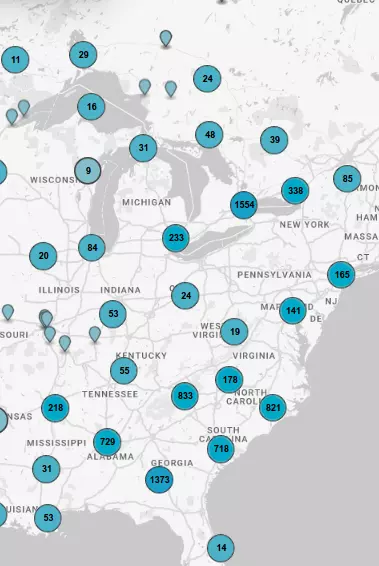The Chase and a Battle
250 yards To the left over the railroad crossing stood a water tower where the famed "General", of "The Great Locomotive Chase" stopped for water while being chased by the "Texas", April 12,...
- lat34
Campaign for Atlanta: Johnston's Review
On April 19, 1864, General Joseph E. Johnston reviewed the Confederate Army of Tennessee on this ridge. After his appointment in December 1863, Johnston rebuilt a defeated and demoralized...
- lat34
The McCarty Subdivision
John B. McCarty began laying out a neighborhood here in 1928. By 1950, influential Dalton residents had established one of the city´s earliest subdivisions using New South landscaping. Tudor...
- lat34
African-American Soldiers in Combat
Near Dalton on August 15, 1864, during the Civil War, the 14th United States Colored Troops (USCT), whose enlisted men were mostly former slaves, helped drive off a Confederate cavalry attack...
- lat34
General Cleburne's Proposal to Arm Slaves
Here on January 2, 1864, Gen. Patrick Cleburne proposed arming slaves in exchange for their freedom to alleviate the manpower shortage facing the Confederacy. Almost all the other generals present...
- lat34
Wilcox County
This County was created by Act of the Legislature Dec. 22, 1857. Georgia Archives show that it was named for Capt. John Wilcox though some authorities believe it was named for his son Gen. Mark...
- lat34
Jefferson Davis
On May 4, 1865, Jefferson Davis arrived in Washington, Georgia (178 miles NE of the Park), where he performed his last duties as President of the Confederate States of America. Shortly thereafter,...
- lat34
Jefferson Davis
Late on May 8, 1865, Jefferson Davis, with his family and a small escort, camped in Abbeville, unaware that hostile pursuit was close behind. His pursuers, the 1st Wisconsin Cavalry [Federal],...
- lat34
New Hope Primitive Baptist Church
New Hope Primitive Baptist Church was constituted in July 1830. The Presbytery officiating were Wilson Conner, David Wood and Jordan Baker. Minutes of the church for the first 12 years were lost...
- lat34
Battle of Breakfast Branch
Near this spot on March 9, 1818, 34 men of the Telfair County Militia, commanded by Major Josiah D. Cawthon, engaged about 60 Creek Indians in combat. Four Indians and five whites, including Capt....
- lat34
DeSoto Trail
Hernando de Soto discovered Ocmulgee at or near Abbeville on April 3, 1540. `Here,` says the chronicler Biedma, `we found a river that had a course not southwardly, like the rest we had passed,...
- lat34
Wilkes County
Wilkes County, an original County, was created by the Constitution of Feb. 5, 1777 from Creek and Cherokee Cessions of June 1, 1773. At first, it contained all of Oglethorpe, Elbert, Lincoln,...
- lat34
Jefferson Davis
On May 4, 1865, Jefferson Davis arrived in Washington where he performed what proved to be his last duties as President of the Confederate States of America. Shortly thereafter, with a small staff...
- lat34
Rock Methodist Church Wilkes County
Rock Methodist Church was instituted about 3 miles from here in 1839. The present building was erected in 1870. Charter members were Tom and Lizzi Willis; John and Mary E. Mattox; John P., Martha,...
- lat34
Battle of Kettle Creek
The Battle of Kettle Creek, fought here on February 14, 1779, was one of the most important battles of the Revolutionary War in Georgia. At that time, the State was almost completely under British...
- lat34
Heard's Fort (Early Georgia Capital)
Heard`s Fort was designated the Seat of Government for Georgia on February 3, 1780. The Executive Council met and Transacted the affairs of the State in this temporary Capital until early...
- lat34
First Court North of Augusta
Near here, in the home of Jacob McLendon, the first Court held north of Augusta convened August 25, 1779, by order of the Executive Council of Georgia. Absalom Bedell, Benjamin Catchings, William...
- lat34
Smyrna Church
Smyrna Church was organized about 1786, by Rev. John Newton and the Rev. John Simpson, Presbyterian ministers ender the Jurisdiction of the South Carolina Presbytery. Services were At first held...
- lat34
Historic Dugas Home
This home was built by Mr. and Mrs. Louis Dugas, French refugees from Santo Domingo, in the early 1790s. Here, until 1810, Mrs. Dugas conducted the Boarding School For Select Young Ladies which...
- lat34
First Methodist Church
Organized in 1819, this Church is an outgrowth of Grant´s Meeting House, the first Methodist Church building in Georgia, erected 5 miles E, in 1787. In 1820, the Methodists built the first...
- lat34
